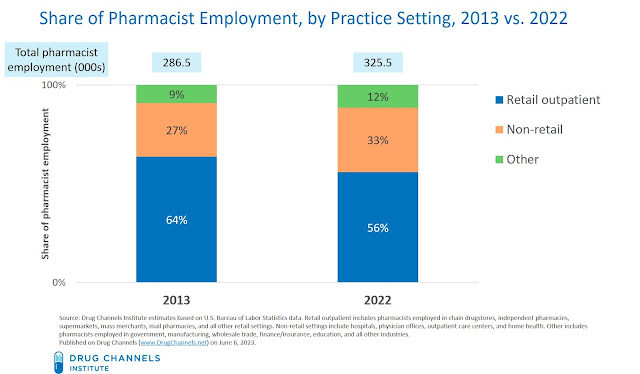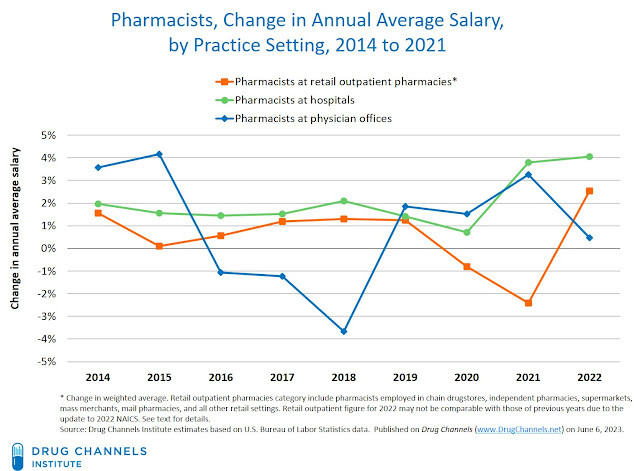Pharmacist employment in retail settings rebounded to its pre-pandemic levels, while non-retail settings—hospitals, physician offices, outpatient centers, and home healthcare—continued to add positions. For 2022, nearly half of pharmacists now work in non-retail practice settings.
Average base salaries for retail pharmacists grew for the first time in three years, to about $124,000. What’s more, retail salaries grew at the fastest rate in years—reflecting the post-pandemic employment environment. Pharmacists employed by hospitals and other non-retail settings also saw higher salaries, which averaged about $139,000. Full salary data below for your enjoyment or sorrow.
The post-pandemic period has been unexpectedly positive for the salaries of retail-employed pharmacists. But I expect the retail pharmacy shakeout to resume. As Bob Marley noted: “The good times of today are the sad thoughts of tomorrow.”
Be sure to join me for my new live video webinar, PBMs and the Battle Over Patient Support Funds: Accumulators, Maximizers, and Alternative Funding, on June 23, 2023, from 12:00 p.m. to 1:30 p.m. ET. Click here to learn more and sign up.
TREND TRACKING
The table below profiles overall employment and salaries for U.S. pharmacists in 2022. We rely on data from the U.S. Bureau of Labor Statistics (BLS). Details on the data and our methodology appear at the bottom of this article. As we note, there was a significant change in how the BLS reported the 2022 data. Therefore, the retail outpatient figures are not fully comparable to our previous analyses.
[Click to Enlarge]
Our observations about the recent employment and salary trends:
- Overall retail pharmacist employment rebounded in 2022. The BLS reported that there were more than 182,000 pharmacists employed at all retail outpatient settings: chain drugstores, independent pharmacies, supermarkets, mass merchants, and mail pharmacies.
For 2021, retail pharmacist employment had declined by about 7,000. Employment in 2022 rebounded to a level that was roughly equal to 2020’s pre-pandemic figure. However, total employment in retail settings has declined from its peak of about 189,000 pharmacists in 2017.
- Hospitals and physician offices continue to grow as a source of pharmacist employment. Total U.S. pharmacist employment has grown, from more than 286,000 in 2013 to more than 325,000 in 2022. The share of pharmacists employed in non-retail settings—hospitals, physician offices, outpatient care centers, and home health—grew significantly during this period, from 27% in 2013 to 33% in 2022. Consequently, pharmacist employment at non-retail settings grew by about 28,000 from 2013 to 2022.
Note that the non-retail figure likely understates pharmacist employment by hospitals. That’s because hospital-owned retail pharmacies are included within the retail category. (See our Notes for Nerds, below.) The share of pharmacists working in non-retail settings was unchanged compared with the 2021 figure, due to the rebound in retail employment discussed above.
[Click to Enlarge]
INCOME OUTCOMES
Observations about recent salary trends:
- Retail pharmacists' salaries grew in 2022. Overall average salaries across all industry settings were $129,410—a 3.0% increase over the 2021 figure of $125,690. However, those in retail outpatient dispensing formats experienced the fastest growth in average wages since 2021 (+2.5%; orange line in chart below).
These figures reflect the post-pandemic environment in retail pharmacy. During 2022, some chain pharmacies offered signing bonuses up to $75,000 to pharmacists amid a chronic shortage of pharmacists and pharmacy technicians. CVS and Walmart have reduced their pharmacy hours due to a shortage of pharmacists willing to work in retail settings. Last week, Walmart announced higher salaries for its 3,700 pharmacists, who will now earn base salaries averaging $140,000.
Salary growth for pharmacists working in hospitals remained strong (+4.1%; green line in chart below). Pharmacists working in home health care had the fastest growth of any major practice setting (+11.6%; not shown in chart below).
[Click to Enlarge]
- The salary gap between a pharmacy owner and an employed retail pharmacist has grown for the fourth year. Our analysis of industry survey data indicates that the average pharmacist owning a single pharmacy earned over $200,000 in 2021 (the most recent year for which data are available). Independent pharmacy owner profits improved due largely to better expense control and the administration of COVID-19 vaccines. Owning a pharmacy, with all of its hassles and obligations, remains more lucrative than being an employee. (Note that the "Pharmacies and drug retailers" cetagory includes pharmacists employed by an independent pharmacy as well as the paid owners and officers of incorporated independent pharmacies.)
We rely on the 2022 Occupational Employment and Wage Statistics (OEWS) program (formerly known as the Occupational Employment Statistics program) from the Bureau of Labor Statistics (BLS). BLS and the State Workforce Agencies (SWAs) collaborate on the OEWS survey. BLS funds the survey and dictates its structure, while the SWAs collect most of the data. The OEWS survey categorizes workers by detailed occupations based on the Standard Occupational Classification (SOC) system. For more on these data, see the OEWS FAQ page.
The Pharmacist occupation code is 29-1051. The SOC defines pharmacists’ roles as follows:
“Dispense drugs prescribed by physicians and other health practitioners and provide information to patients about medications and their use. May advise physicians and other health practitioners on the selection, dosage, interactions, and side effects of medications.”Using these data, we identified pharmacists working in various retail and non-retail settings based on the NAICS (North American Industry Classification System).
For the 2022 OEWS, BLS updated from the 2017 NAICS to the 2022 NAICS. Data on pharmacists that had been coded to mail pharmacy establishments within the industry code NAICS 4541 (“Electronic Shopping and Mail-Order Houses”) were placed back into the corresponding retail NAICS shown in the table above. Consequently, the figures for the retail outpatient subcategories will not be precisely comparable to the figures reported in our previous analyses. For clarity, we have listed the NAICS 2022 codes that correspond to each practice setting.
A few more items of note:
- BLS computes the annual wage data by multiplying an hourly mean wage by a "year-round, full-time" figure of 2,080 hours. These data exclude bonuses and employer costs of nonwage benefits, such as health insurance and contributions to retirement plans.
- Pharmacists employed by an independent pharmacy are included, as are paid owners and officers of incorporated independent pharmacies. However, the data exclude business owners and partners in unincorporated pharmacies.
- The data show the location of employment as a "pharmacist." They do not specify the duties that the pharmacists perform or the entity that operates the pharmacy.
- The NAICS industry code “446110 Pharmacies and Drug Stores” includes drug stores, pharmacies, and on-site institutional pharmacies. Thus, a pharmacist employed in a hospital’s retail outpatient pharmacy may be classified as an employee of a retail pharmacy.




No comments:
Post a Comment